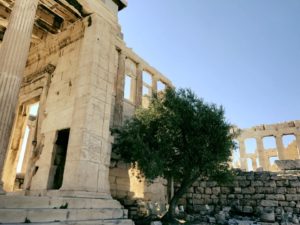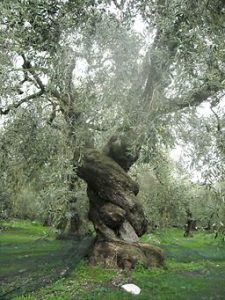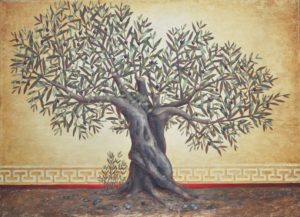The Price Tag on Greece’s Living Heritage
Project Proposal by Nicole Feied and Ada Vlachoutsikou
More than just a picturesque tourist attraction, the centuries-old gnarled olive trees of Greece are central to the very history and culture of Ancient Athens. Even the name of Athens was chosen, according to Greek mythology, when the Goddess Pallas Athena planted the first olive branch, from which the all the sacred olive trees (Moriai) of Attica are said to be propagated.

In thanks, Attica chose Pallas Athena as their patron Goddess and protector. To this day, an olive tree still grows atop the Acropolis, said to be repropogated again and again over the past, from the original Athenian Moria. These moriai were highly protected in ancient times, with regular inspections and severe penalties imposed on those who dared to destroy them.
Now, however, no such protections exist. Olive trees planted as long ago as two thousand years can still be found all over Greece, particularly around ancient archaeological sites, but to date these treasures have not been counted or mapped. Thousand-year old olive trees are being destroyed with no notice being taken; neither by the government nor by environmentalists. These trees are being cut down to make way for new roads or buildings, and there is now strong evidence that the ancient trees are even being uprooted to be sold as decorative plants in wealthier European countries.

Finally, in recent years Europe has been facing a more general threat to olive trees; the deadly bacteria Xylella fastidiosa, a plant pathogen which threatens olive groves in France, Italy and Spain. While there is apparently no immediate threat to Greek trees, this serves as a potent reminder that there may be other dangers to the moriai, and all the more reason to preserve as many as possible.

As an initial step in addressing this problem we propose a review of existing Greek and other European legislation regarding protected trees, and development of a proposal for appropriate legislative solutions or processes.
Relevant material will be created to raise public awareness and communicate the cultural, historical and environmental importance of these trees. This will include an interactive website with materials for social media pages such as Facebook, Instagram, Tumblr etc., as well as materials for schools such as a leaflet and a social satire skit for television and YouTube.
This first stage is a short 3-month project, which can create a baseline of information and further action, while in itself contributing to increased awareness and potentially even spurring action. As a later, second stage, the ancient olive trees will need to be mapped for a public online database.

ANCIENT OLIVE TREE SURVIVAL
Action Plan and Budget
The project responsible will be Ada Vlachoutsikou, who will coordinate the project development and submission of the outcome to relevant bodies to promote effective outcome and future action.

